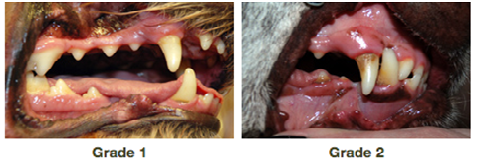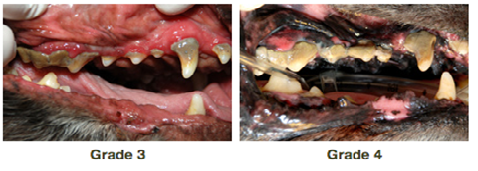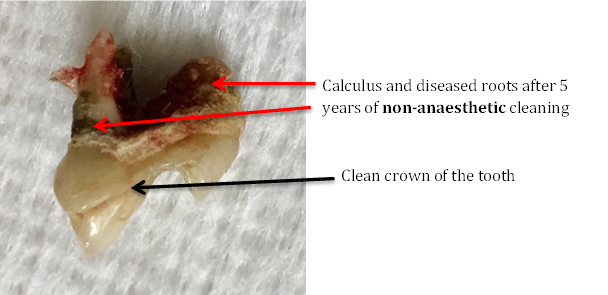Healthcare
Dentistry
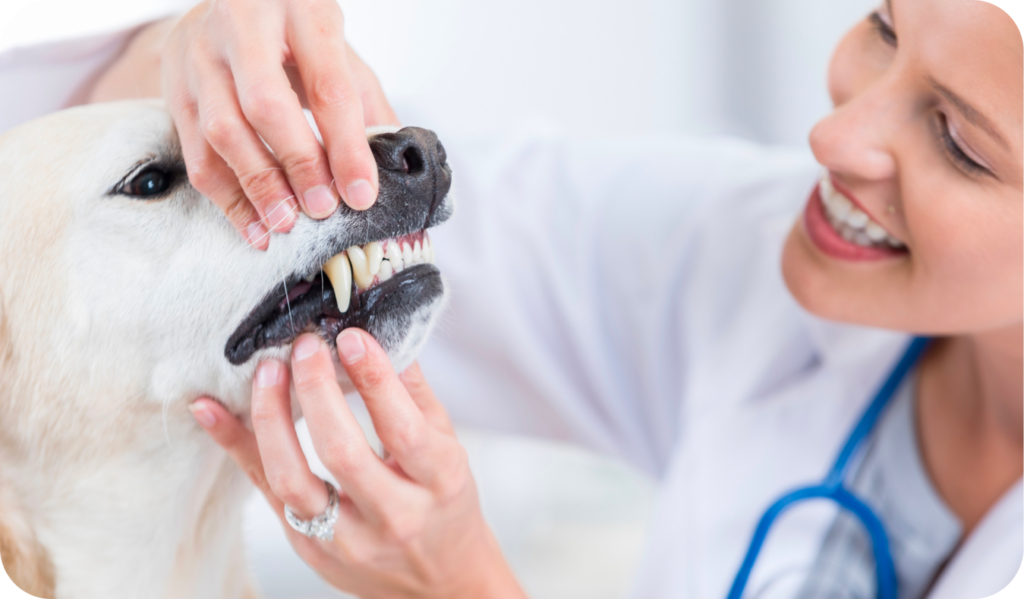
Oral health is one of the most important aspects of pet care in dogs and cats. Dental disease affects the tooth crown and roots. Periodontal disease affects the structures around the tooth. These structures are the gingiva (gums), periodontal ligament (the ligament that holds the tooth in position in the jaw), and alveolar bone (the bone of the tooth sockets and the jaw). Dental disease and periodontal disease affects 85% of dogs and cats over the age of 3.
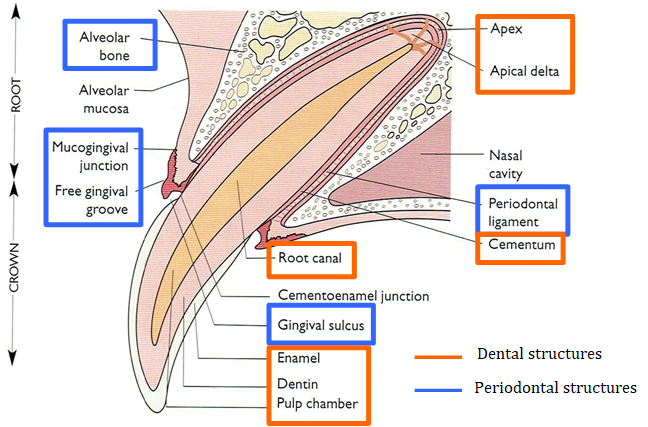
Periodontal disease all begins with the formation of plaque in the mouth. Plaque isn’t visible to the naked eye, and it is formed from food particles and bacteria mixed with saliva. Plaque attaches to the tooth surface, and can be removed from the tooth by brushing or chewing. If plaque is not removed adequately and regularly, then the bacteria in the plaque start to cause inflammation of the gingiva, causing gingivitis. Over time the plaque starts to mineralise into calculus and tartar, which cannot be removed by brushing or chewing and continues to harbour bacteria.
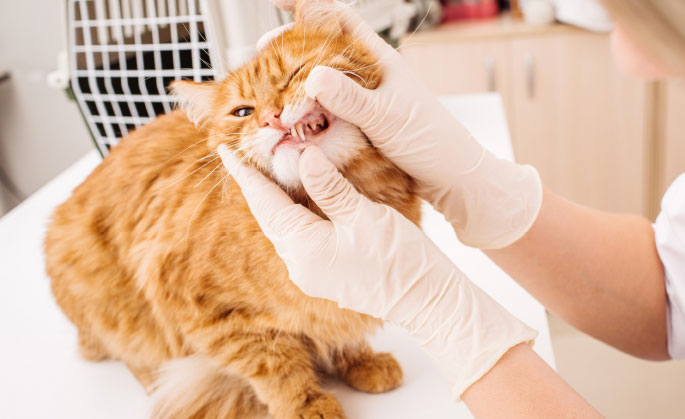
If gingivitis is not managed and treated, then the inflammation and infection progresses and starts to breakdown other periodontal structures, which will eventually lead to teeth falling out. This is a painful process, and can have significant implications for overall health, often shortening the lifespan of our beloved companions.
The inflammation first affects the gingiva, and can lead to changes in its structure allowing more bacteria under the gum. As bacteria infect the tissue under the gum, it starts to break down the periodontal ligament that holds the tooth in position. This allows more bacteria to extend into the socket of the tooth, and come in contact with alveolar bone. The infection then eats away at bone, causing loss of important structures of the jaw. The bacteria infecting the periodontal structures will also enter the blood stream, which can lead to bacterial endocarditis (infection of the heart and valves), liver infections, and damage to the delicate structures of the kidneys.
There are some factors which may cause Periodontal Disease to develop more quickly in some individuals, such as:
- Overcrowded teeth
- Abnormal jaw occlusion (e.g. under bite or overbite)
- Retained baby teeth (deciduous teeth)
- Long hair around the mouth
- Predominantly soft food diet
- Immune suppression
- Abnormal saliva enzymes in certain breeds or individuals (e.g. Maltese Terriers and Greyhounds)
Initially, Periodontal Disease might not be visible if it is plaque only. Once the plaque starts to create gingivitis and calculus then we can start to see the signs.
Some owners may look at their pet’s teeth at home, and see the visible signs of Periodontal Disease.
Others first notice the early signs such as bad breath (halitosis), which is produced by oral bacteria. Some people notice a change in their eating habits, reporting that their pet chews on one side of their mouth, prefers wet food to dry food, or resents their mouth being touched. These can be signs of oral pain in some animals.
Many owners report that their pet “doesn’t seem painful because they are still eating”. Periodontal disease is painful, but many animals won’t show obvious signs of oral pain and will continue eating, even with severe oral disease. Almost every vet will tell you that they have seen many cases of horrific dental and periodontal disease in dogs and cats that are still eating. In those cases, once the dental and periodontal disease is treated, many owners will later say that their pet is suddenly livelier and more playful. We know from human dentistry that dental and periodontal disease is painful, and we determine the same to be true for our four-legged friends.
Periodontal Disease is graded on a scale of 1 to 4, with 1 being the lowest grade.
Grade 1 Periodontal Disease
Plaque will be present, and early signs of tartar may be developing on the teeth. The gingiva may be starting to become slightly red and slightly swollen with mild gingivitis. This level of Periodontal disease is often reversible with appropriate homecare and management.
Tartar and calculus will be clearly visible on several teeth, with more pronounced gingivitis. The edges of the gingiva that meet the tooth will be noticeably red, and swollen. It is likely that mild oral pain is developing. This level of Periodontal Disease is often reversible with a professional veterinary scale and polishing procedure.
Source: Olney-Sandy Spring Veterinary Hospital
Significant tartar and calculus is present over multiple teeth, with significant gingivitis. The gingiva is red and swollen, and there will be some recession of the gingiva away from the tooth, exposing some of the tooth roots. Some teeth may be becoming loose. With Grade 3 disease, there is likely to be some bone loss, and is very likely to be causing significant oral pain. This level of Periodontal Disease requires a professional veterinary scale and polish procedure, and the change in the gingiva and bone are often irreversible, resulting in tooth extractions.
Severe tartar and calculus is present over multiple teeth, with severe gingivitis. There is significant gingival recession, exposure of multiple tooth roots and the presence of multiple loose teeth. Oral pain is noticeable with Grade 4 disease, and there is irreversible damage to multiple teeth. This level of Periodontal Disease requires a professional dental procedure that will result in multiple tooth extractions, and may require other treatments such as pain relief and antibiotics.
Long-term control and prevention of dental disease requires regular home care. The best way to begin this is to acclimatise your pet from a young age. Dental home care may include:
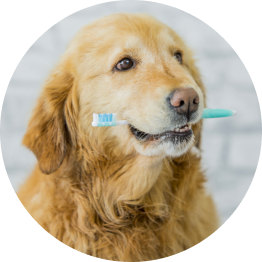
Brushing Teeth Daily
Just like us! This is the best form of dental hygiene. Pet toothbrushes and toothpaste are now available. Please do not use human toothpaste formulas as they are not designed to be swallowed and may be toxic to your pet.
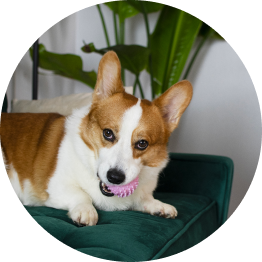
Teeth Friendly Chews and Toys
Use dental toys, enzymatic chews, or teeth cleaning biscuits, all of which may help keep the teeth clean.

Special Dental Diets
Feed pets special dental diets. This can help reduce the accumulation of tartar.
As with most things in life, when it comes to dental disease, prevention is definitely better than cure. Regular and frequent attention to your pet’s teeth may avoid the need for a professional dental clean under anaesthetic, and will also improve your pet’s overall health.
At North Maclean Family Vet, we offer COMPLIMENTARY dental checks all year round, by our team of qualified nurses, to help you create a management plan suited to your pet. Ask us about our wide range of dental preventatives!
It is similar to a scale and polish done by a dentist for us, however, unlike us, our pets won’t sit still or open their mouth to allow a comprehensive examination or cleaning of their teeth. For this reason our pets need to have a general anaesthetic for a professional dental assessment and clean. Your pet will need to be assessed by one of our veterinarians. The degree of dental disease will be assessed to determine what type of treatment is required.
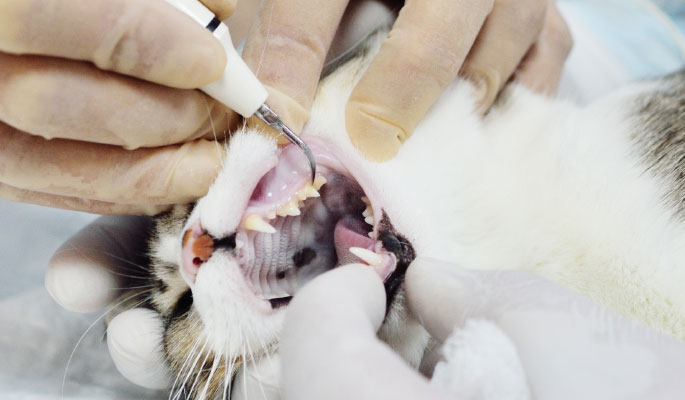
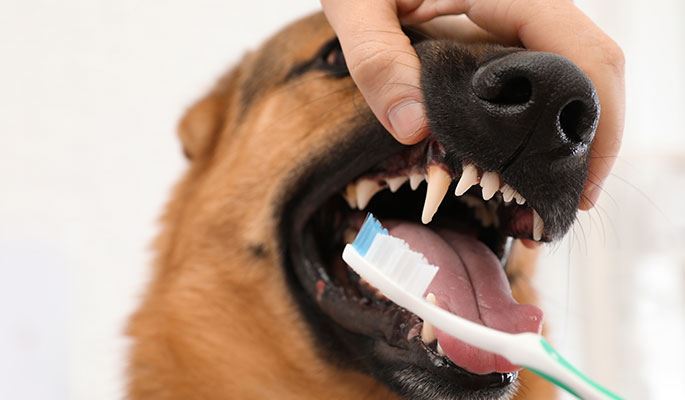
Tooth fractures can occur in animals of any age in ways such as chewing hard objects, or trauma (e.g. impact with a hard object such as hit by a car). Some fractures involve only the crown of the tooth, and others can extend up through the roots of the tooth. Fractures that involve dentin are quite painful, and exposure of the pulp cavity risks bacteria entering the tooth root from the fracture site. For fractures involving the pulp chamber, a root canal can be performed by a specialist veterinary dentist and is considered a referral option. Some owners elect this option as a method of preserving the tooth as a whole, maintaining the function and cosmetic appearance of the tooth. Without referral for a root canal, the option for treatment of such a tooth is extraction. For fractures that involve the tooth root, extraction is the recommended treatment option to prevent infection extending into the tooth roots. Diseased tooth roots can cause abscesses and significant damage to the alveolar bone.
The image above shows pulp exposure in a fractured canine tooth. Souce: Advanced Animal Dentistry
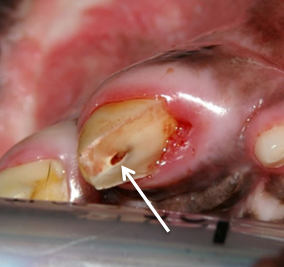
Feline Oral Resoprtive Lesions (FORLs)
FORLs are a disease that results from abnormal activity of odontoclasts. Odontoclasts are cells that break down the structures of teeth and roots, and are normally only active during the change from deciduous (baby) teeth to adult teeth. Normally, they retain no function in an adult. In cats, however, stem cells found in the periodontal ligament can turn into odontoclasts in an adult, and start to break down the structures of healthy adult teeth. How and why this occurs isn’t fully understood, but it is reported that FORLS occur in up to 74% of cats over the age of 6!
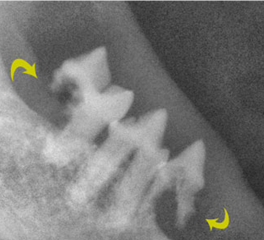
Signs of FORLs may be seen as uncharacteristically cranky or aggressive behaviour (due to pain), interest in food but reluctance or difficulty eating, mouth chattering after eating or drinking, or preference of chewing on one side. As the odontoclasts eat away at teeth, they expose the sensitive dentin and eventually the pulp of the tooth, causing intensely painful tooth lesions. Some of these lesions may be visible along the edge of the gingiva, but many occur beneath the surface. FORLs that occur along the tooth root aren’t visible to the naked eye, but are just as painful. Dental x-ray is needed to confidently identify all active FORLs in the cat’s mouth at the time of a dental procedure, if any are identified, the affected teeth must be extracted.
The image above shows FORLs seen on dental x-ray. Source: The Cat Clinic, Ontario
Feline Oral Resoprtive Lesions (FORLs)
There is a growing trend of no-anaesthesia, non-veterinary dental procedures being performed. Many people claim they can clean an animal’s teeth and provide the same level of care without the need for anaesthesia or veterinary training. This runs a great risk of not identifying significant dental and periodontal disease, and therefore not adequately or appropriately treating it. Without anaesthesia we can only hope to clean the crown of the tooth, but as we have discussed in this information sheet, periodontal disease affects the structures around the tooth and the roots. Anaesthesia is needed to be able to effectively explore and clean the structures beneath the gingiva without causing significant stress, discomfort and pain to the animal. Tooth extraction is an invasive procedure, and whilst we give local anaesthetics for the focal pain at the tooth site, a general anaesthetic in required to keep the animal still and relaxed during the procedure.
Anaesthesia is essential in order to perform a comprehensive oral examination, adequately perform an effective dental scale and polish, and treat dental and periodontal disease.
If you are concerned about anaesthesia for your pet, then please come in and speak with your vet about what is involved and the options available.
Example of a diseased tooth following inappropriate management with non-anaesthesia dental cleaning. The crown of the tooth has been cleaned, but the structures below the gum line have not be managed or treated and have become severely diseased resulting in extraction of the tooth.
Source: Arizona Veterinary Dental Specialists
If you have any questions about dental care or professional cleaning please do not hesitate to contact us on (07) 3297 0803

